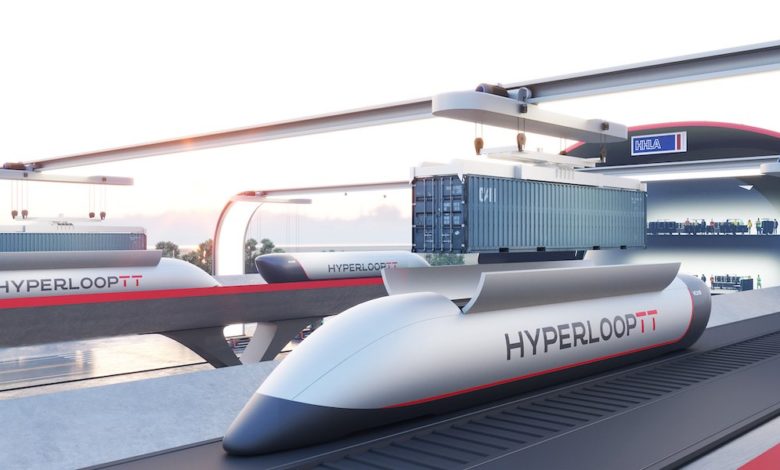Hyperloop box system unveiled

German port operator Hamburger Hafen und Logistik AG (HHLA) and America’s Hyperloop Transportation Technologies (HyperloopTT) will showcase a new way of moving containers from ports to inland destinations at an upcoming conference.
HyperloopTT and HHLA entered into a cooperative agreement at the end of 2018. HyperPort was developed based on current industry standards and is a plug-and-play solution for port operators. The concept makes it possible to transport containerised goods at high speed over hundreds of kilometres. The system can move up to 2,800 containers a day in a closed operating environment, without traffic or environmental influences. The individual HyperPort transport capsules provide room for two 20-foot or one 40- or 45-foot standard or high cube container.
The transport capsules were designed by the Spanish industrial design company Mormedi while the technology was developed in cooperation with the Spanish engineering firm CT Ingenieros and is already construction-ready.
“Using the same underlying technology as our passenger systems, the HyperPort can future-proof supply chains and simultaneously relieve the burden on port regions,” said Andres De Leon, CEO of HyperloopTT.
“At HHLA, we know that to prepare for the future you must innovate,” said Gerlinde John, project manager HyperPort at HHLA. “The Hyperloop technology is suitable of taking the transport of goods to a new level. With the HyperPort concept, we are developing an alternative solution to existing transport systems for the goods transport of the future in a fast-growing global market.”
Other freight loop concepts currently under development include DP World Cargospeed, a partnership between Dubai-based DP World and Virgin Hyperloop, based in California, while Splash reported last week on Elon Musk’s development of a 6.4 m wide tunnel concept capable of transporting two lanes of containers.

This is pure fantasy. The capital costs of construction (assuming planning consents) will be phenomenal. There is no linkage to existing rail systems and the claimed speed advantage outweighs the value of the cargo and the ability of shippers to pay. Other systems (mag-lev) were promised as a way forward but all have crashed and burned when commercial and economic reality kicked in. Desirability, feasibility and practicality issues seem to have been wholly overlooked.
The desirability is incredibly high there. The only questions are about how cost effective can they make it, and how long until it’s safe & effective
But it has to be awesome! Just look at all the CGI that goes into it!
This “tech” is a sham reheated in a microwave by a conman named Elon… Sold to people who want to believe it so badly and profited on by people who know it’s never going to happen.
Excellent piece of news, especially during the current pandemic.
Hyperloop doesn’t even exist yet and never will in the fantasy form that has been promised in . The Vegas Loop is what you can expect from the overall hyperloop scheme.
I guess that doesn’t stop them from making more promises huh.
Dosen’t seem practical, probably thousands of containers come out of LA-Longbeach every day, you’re going to need a LOT of them!
They do not own the patent for that circular cross section vehicle. They are ripping off the IP owner.
There are definitely engineering advantages transporting containers instead of humans. The main one being containers don’t need oxygen.
That said, there is absolutely zero chance of such a system being even remotely commercially feasible.
You’d need to construct tunnels 100s of kilometers in length to only gain a few minutes of advantage over “normal” high-speed rail. And that rail would be much, much cheaper.
This project has already failed before it has even begun.
All hyperloop projects are scams they will not not work.
This was already news in 2018. Google HHLA and Hyperloop.
Not sure what kind of milestone they think they’ve reached to get this in the news again 3 years later.
And still, this is all dreams, plans and concepts. This is never going to work in reality.
What a puff piece. Language like “Hyperport was developed” and “the system can” imply that this is something more than vapourware designed to harvest yet more venture capital in what is a hundred-year-old thought bubble that is destined to pop when practical reality sets in.
Did you know that there is already a technology that “can move up to 2,800 containers a day in a closed operating environment, without traffic or environmental influences”? It’s called a freight train.
The Hyperloop for containers, could mean that container ships from Asia, would no longer need to go through the Panama Canal for deliveries to the East Coast, and actually anywhere in the east of the Missippi, in the heartland/interior of America,. generally . With a “rib” system, off of a “transcontinental backbone”, no more long haul trucking.(a cutting of CO2 emissions also) I.e. delivery of a container anywhere in the US within 36 hours of porting at any of several locations the West Coast. Much faster service, though a new vulnerability to SNAFU’s of every sort – including cyber no doubt.
Now if the Hyperloop system was to be used to carry Postal Mail, the whole network to be could be declared “a Post Road”, noted in the US Constitution, which has any number of implications re eminent domain in setting up routes, financing, etc. (Railroads in an earlier era, were declared Post Roads, as mail was carried on, and sorted in, special RR mail cars. Does anyone know about that ?)
An actually working example of a hyperloop is not in existence. It only exists in a Musk paper riddled with errors/misrepresentations and CGI. The “test track” isn’t even close to what’s proposed.
Time to let this fantasy go. Real people are losing real money on this “project”. Let’s fund something that could work.